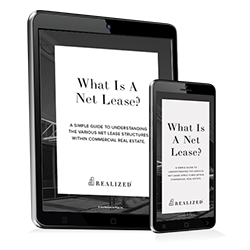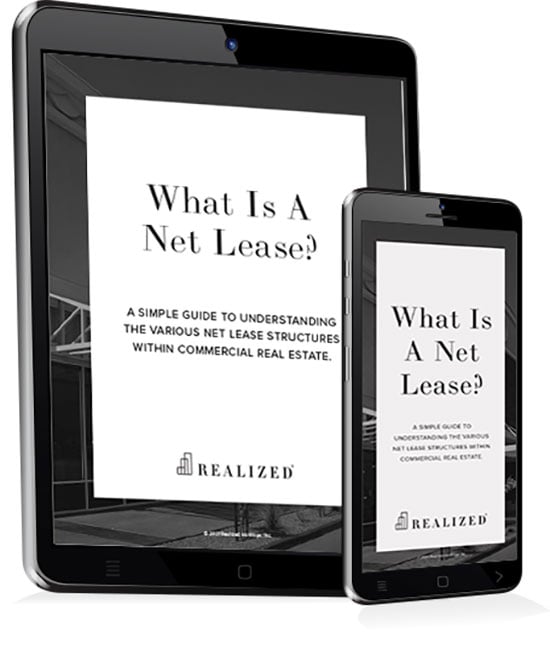
“Better safe than sorry” is an adage that often gets overlooked in the world of real estate investing. When evaluating a potential property, calculating the expected return is relatively easy, but understanding the associated risks is really difficult. What’s a real estate investor with a lower tolerance for risk to do?
Single Tenant Net Lease (STNL) properties are a popular option, particularly for investors doing a 1031 exchange who no longer want the day-to-day burden of being a landlord. STNL properties can be great investments, but they aren’t without risk.
This post will highlight the risks investors should consider when weighing an investment in an STNL property.
STNL properties are usually free-standing, specialized buildings leased to household name brands under long term triple net (NNN) leases. Single tenant net lease investments are also referred to as “NNN properties" or “Net Lease” properties. The NNN refers to the nature of the triple net lease, which requires the tenant to pay (in addition to the rent) property taxes, insurance, and maintenance on the property.
STNL investments are appealing because they require limited ongoing landlord responsibilities, and provide the owner with a long-term, predictable stream of rental payments.
Sounds great, right? It can be—as long as everything goes as planned, which lends itself to one of the first risks of NNN investing.
Risk #1: Vacancy
STNL properties are either 100 percent occupied, or 100 percent vacant. With only one tenant, if a company goes out of business or leaves, the rent goes to zero and you (the owner) are responsible for the taxes, insurance, and maintenance.
What does an investor do with a vacant, former Burger King or Chick-fil-A? Lease it to another fast food restaurant, of course! Oftentimes, this is easier said than done. There’s a reason that XYZ chain is no longer occupying the property, and it likely has something to do with the location. This highlights risk number two.
Risk #2: Location Matters
Don’t get enamored with a high profile tenant, or the “above-average returns” a property promises to generate. At the end of the day, STNL properties are real estate investments.
A vacant building that was previously home to Tractor Supply or Dollar General is incredibly difficult to re-lease at the same rent if it’s located in Truth or Consequences, New Mexico, or Tyrone, Pennsylvania.
Even if a property is located in a large metropolitan area, you still need to pay attention to the location. How much is the next buyer willing to pay eight years from now for an Applebee’s in a marginal neighborhood that only has two years left on the lease?
Let’s go to the other extreme by assuming an STNL has a really good location, but the tenant for whatever reason doesn’t make it or decides not to renew the lease. Even if other tenants are standing in line to lease the property, a former Wendy’s or branch bank is not generally considered generic real estate. This highlights the next risk.
Risk #3: Specialized Buildings
Typically, STNL properties are designed and built to meet the requirements of a specific tenant. Re-leasing an STNL property to a different type of tenant can take a long time and cost the landlord a significant amount of money.
The more specialized a building is, the greater the amount the next tenant will expect the landlord to contribute in upfront tenant improvements. Even if a building is in an A+ location, marketing and lease negotiations can easily mean no rent for six to 12 months. This can be particularly challenging for an absentee investor who lives far away from the property and/or does not have the capital necessary to attract the best tenants.
For these reasons, investors considering an NNN property should be vigilant in understanding a tenant’s ability to pay the rent. Often, STNL buyers, particularly those in 1031 exchange 45-day identification periods, don’t pay much attention to the lessee on the hook for paying rent. This is the next major risk of which NNN investors should be aware.
Risk #4: False Sense of Security From a Corporate Brand
Just because a household brand name is on the sign out front doesn’t mean that the corporation behind it is obligated to pay the rent.
It might come as a surprise, but it’s fairly rare that well-known corporations actually sign a lease. Just because the tenant is Wendy’s, Best Buy, or Exxon, doesn’t mean those publicly-traded companies are paying the rent. Even if the property is a “company store,” the lessee is typically a subsidiary, and the parent company may or may not be guaranteeing the rent payments.
Risk #5: Failing to Understand the Tenant’s Ability to Pay Rent
Make sure you do your due diligence on the tenant to ensure they have the financial wherewithal to make all the agreed upon rent payments.
The truth is the majority of STNL properties are leased by franchisees, not the corporation traded on the New York Stock Exchange. This is not necessarily a bad thing; franchisees can be very creditworthy. Often, a local franchisee will have 10+ stores in an area, and it’s not uncommon for regional franchisees to operate 50 or more stores across multiple states.
Even if the tenant appears to have strong credit, it’s simple for them to set up a limited liability company (LLC) with a similar name for the sole purpose of signing the NNN lease on a property. Remember, if the tenant is an LLC or corporation that has no assets, it shields even the largest company from having to honor the lease.
The main point here is that investors need to roll up their sleeves and make sure that if a tenant vacates before the end of the lease (for whatever reason), there is an entity on the hook with deep enough pockets to continue paying the rent through the term of the lease.
In his post The Risks and Benefits of Triple-Net (NNN) Properties, Ray Alcorn, a commercial real estate expert, provides some good advice: "In leasing [a tenant] your property, you are essentially providing capital to the business, and their continued success has a direct bearing on the long-term health of your investment. Past history and future prospects are both relevant."
Now, let’s get to the final risk that’s so easy for yield-hungry investors and 1031 exchangers to overlook.
Risk #6: Interest Rate Risk
The value of STNL properties is very sensitive to changes in interest rates.
It’s appealing to think about receiving a six, seven, or even eight percent return from an STNL property each year. Who doesn’t like “mailbox money” that shows up right on time each month? Many investors think about STNL properties more like fixed income, bond-like investments instead of real estate. This is understandable, with tenants like Walgreens, Bank of America, or other large franchisees guaranteeing the rent payments.
But, there’s a catch. On the plus side, STNL are similar to bonds, as they represent a series of fixed payments over a specified timeframe. On the downside, just like bonds, when interest rates go up, the value of STNL properties goes down. You’ll hear people argue this point, but it’s a fundamental principle of finance. The fixed rent structure of STNL properties makes them more susceptible to interest rate risk than most other types of real estate.
While interest rates have been at historical lows for more than a decade, that doesn’t mean they will stay there for the long-term. There’s never a guarantee that rates will stay low—and this uncertainty is the risk.
Risk #7: Length Of The Lease
Long-term tenants create cash flow stability for a property. But as a tenant’s end of lease approaches, the landlord will need to be clear on what the tenant will do next. Tenants that aren’t renewing their lease should give plenty of notice per the terms of their lease. It can be difficult and time-consuming to find a long-term tenant. Landlords need plenty of time to plan the tenant transition. Otherwise, they may be stuck with an unexpected and costly vacancy.
Each tenant brings with them their own terms of what they expect from the property. Some tenants may be happy with the current property and require few changes, while others may require many changes. If a landlord doesn’t have any great prospects for a long-term tenant, they may be forced to take on a less desirable tenant (i.e., a short-term tenant that requires lots of changes) or suffer a loss of cash flow. For stand-alone buildings, this can be devastating as there is only one tenant for the entire property.
As the remaining lease becomes shorter, the property will likely decrease in value. Much of a property’s value is derived from its tenants’ long-term net lease. The sooner those tenants renew their leases, the more stability the property will experience.
Final Thoughts
With all the risks outlined above, it’s important to emphasize that we do not advocate that investors avoid STNL properties. STNL/NNN properties can be great long-term investments, but they do carry “hidden risks,” which is why they are important to know, and why investors need to do their homework before they invest.
When evaluating real estate investments, understanding the potential risks can often be difficult. On the flipside, calculating expected returns is relatively easy. With an STNL investment, the greatest challenge most investors face is resisting the urge to believe that STNL investments are risk-free. Unfortunately, the only way to determine what the real risks are in a real estate investment, or in life for that matter, is with the passage of time. But one of the best ways to mitigate your risk is to make sure you understand all the risks involved before making the investment.



